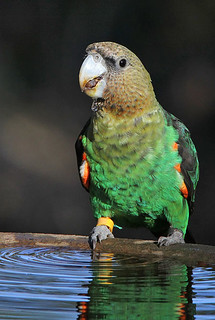 Red visiting a suburban birdbath. Image by Rodnick BiljonHappy news for Cape parrot fans is that “Red”, a wild-born female Cape parrot rehabilitated from a deadly viral infection and released back into the wild in 2011 has been seen on several occasions visiting a suburban birdbath, apparently healthy and living the life.
Red visiting a suburban birdbath. Image by Rodnick BiljonHappy news for Cape parrot fans is that “Red”, a wild-born female Cape parrot rehabilitated from a deadly viral infection and released back into the wild in 2011 has been seen on several occasions visiting a suburban birdbath, apparently healthy and living the life.cape parrot
The female Cape parrot (Poicephalus robustus) was one of four handed over to me in May 2011. All four were severely malnourished and suffering from the deadly Psittacine Beak and Feather Disease (PBFD). My wife and I (plus a few willing helpers) nurtured the four parrots for six intense months before releasing them back into their native range in South Africa’s Eastern Cape Province.
cape-parrots
 Red visiting the same suburban birdbath. Image by Rodnick BiljonThe ailing parrots could barely walk out of their holding cages when they arrived, but a healthy diet of indigenous food (including their favourite yellowwood nuts) and a stress-free environment led to a steady recovery and eventual successful release for all four of the parrots.
Red visiting the same suburban birdbath. Image by Rodnick BiljonThe ailing parrots could barely walk out of their holding cages when they arrived, but a healthy diet of indigenous food (including their favourite yellowwood nuts) and a stress-free environment led to a steady recovery and eventual successful release for all four of the parrots. Red (flying, yellow leg band) mingles with wild birds shortly after her release. Image by Rodnick BiljonWe nicknamed this female “Red” because of the large amount of red on her forehead at the time she was with us. Of interest is that 3 ½ years later the red has completely vanished. Usually young Cape parrots show various amounts of red in the forehead, which then almost totally disappears in males as they mature. Females, however, usually retain the red forehead – so Red’s situation poses questions.
Red (flying, yellow leg band) mingles with wild birds shortly after her release. Image by Rodnick BiljonWe nicknamed this female “Red” because of the large amount of red on her forehead at the time she was with us. Of interest is that 3 ½ years later the red has completely vanished. Usually young Cape parrots show various amounts of red in the forehead, which then almost totally disappears in males as they mature. Females, however, usually retain the red forehead – so Red’s situation poses questions.rehabilitated parrots
 The rehabilitated parrots mingle with wild parrots shortly after their release. Image by Rodnick BiljonRed was the weakest of the four rehabilitated and released parrots, so we have great hope that the other three are also doing well, and have dispersed back to their preferred territories.
The rehabilitated parrots mingle with wild parrots shortly after their release. Image by Rodnick BiljonRed was the weakest of the four rehabilitated and released parrots, so we have great hope that the other three are also doing well, and have dispersed back to their preferred territories.The Cape parrot is endemic to the high-altitude Afromontane mistbelt forests of South Africa where they nest and roost but they also forage in lower lying forests and farmlands. There are fewer than 1 000 individuals left in the wild, making this Africa’s rarest parrot. Major threats include PBFD, habitat loss and illegal capture for the caged bird industry.
Thanks to Lizz Espley, Shelley Prince, Michelle Connolly and Philip Connolly for their help during those six crucial months in these parrots’ lives. Their invaluable help included a strict daily feeding and cleaning routine and harvesting of food from neighbourhood trees (yellowwood, wild plum, assegai, Cape ash etc).
 The four Cape parrots arrive at East London airport the day before release. Image by Simon Espley
The four Cape parrots arrive at East London airport the day before release. Image by Simon EspleyThe female Cape parrot (Poicephalus robustus) was one of four handed over to me in May 2011. All four were severely malnourished and suffering from the deadly Psittacine Beak and Feather Disease (PBFD). My wife and I (plus a few willing helpers) nurtured the four parrots for six intense months before releasing them back into their native range in South Africa’s Eastern Cape Province. - See more at: http://africageographic.com/blog/rehabilitated-and-released-cape-parrot-thriving/#sthash.ouGYF4oO.dpuf
The female Cape parrot (Poicephalus robustus) was one of four handed over to me in May 2011. All four were severely malnourished and suffering from the deadly Psittacine Beak and Feather Disease (PBFD). My wife and I (plus a few willing helpers) nurtured the four parrots for six intense months before releasing them back into their native range in South Africa’s Eastern Cape Province. - See more at: http://africageographic.com/blog/rehabilitated-and-released-cape-parrot-thriving/#sthash.ouGYF4oO.dpuf
The female Cape parrot (Poicephalus robustus) was one of four handed over to me in May 2011. All four were severely malnourished and suffering from the deadly Psittacine Beak and Feather Disease (PBFD). My wife and I (plus a few willing helpers) nurtured the four parrots for six intense months before releasing them back into their native range in South Africa’s Eastern Cape Province. - See more at: http://africageographic.com/blog/rehabilitated-and-released-cape-parrot-thriving/#sthash.ouGYF4oO.dpuf